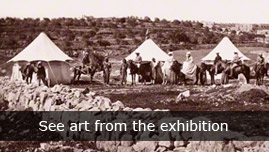| Exhibitions | ||
| Collection | ||
| Education | ||
| Research and Conservation | ||
| Publications | ||
| Games | ||
| Public Programs | ||
| About the J. Paul Getty Museum | ||
Press Kit |
||
| Museum Home
|
March 2–September 12, 2011 at the Getty Villa
|
This exhibition presents photographs created between the 1840s and the early 1900s of the region known variously as Palestine, western Syria, and the Holy Land. Subjects range from architectural sites to scenes of pastoral life. Centered on a strip of land along the eastern Mediterranean—encompassing what is present-day Israel, Jordan, and parts of Lebanon, Syria, and Egypt—the region known as the Holy Land fuses geography with history and belief. The shared legacy of Jewish, Christian, and Islamic faiths formed a space of enormous spiritual significance.
In the 19th century, a new group of visitors, primarily Protestant Europeans and Americans who were deeply immersed in the Bible, experienced a profound discord between the luminous realm in their imaginations and the forbidding reality of the physical terrain. Expecting to find Jerusalem, "the shining city on a hill," in Palestine, "the land of milk and honey," they encountered a dusty, provincial outpost in an arid country. Reality did not discourage interest or deter travelers. Military and economic aims merged with religious fervor and the advent of archaeology. As visitors increased, the Holy Land became a subject for the nascent medium of photography introduced in 1839. Rather than soaring vistas or monumental architecture, photographers captured a more modest scene: ancient villages nestled in a stony landscape, a once-great city subsiding within its walls, and people repeating patterns of life unchanged over millennia. Photographs of biblical sites replaced fanciful illustrations based on artists' sketches—but the medium that promised truth and accuracy would also come to produce distorted views. Drawn from the collections of the J. Paul Getty Museum and the Getty Research Institute, In Search of Biblical Lands features daguerreotypes, salted-paper prints, and albumen silver prints created between the 1840s and the early 1900s by leading photographers of the time, including Félix Bonfils, Felice Beato, Maxime Du Camp, Auguste Salzmann, James Graham, Louis Vignes, Frank Mason Good, and Frédéric Goupil-Fesquet. Organized into five sections—Views of Jerusalem, Early Photographs, Peoples of the Bible, Travels in Bible Lands, and British and French Expeditions—the selections include views of Bethlehem, Nazareth, Jaffa, and Petra, as well as Jerusalem landmarks such as the Church of the Holy Sepulchre, the Damascus Gate, and the Dome of the Rock. Generous funding for this exhibition was provided by the Villa Council. Because photographs are sensitive to light, many of the images will be rotated midway through the exhibition. |
||
|
|
||||||||||||||||

